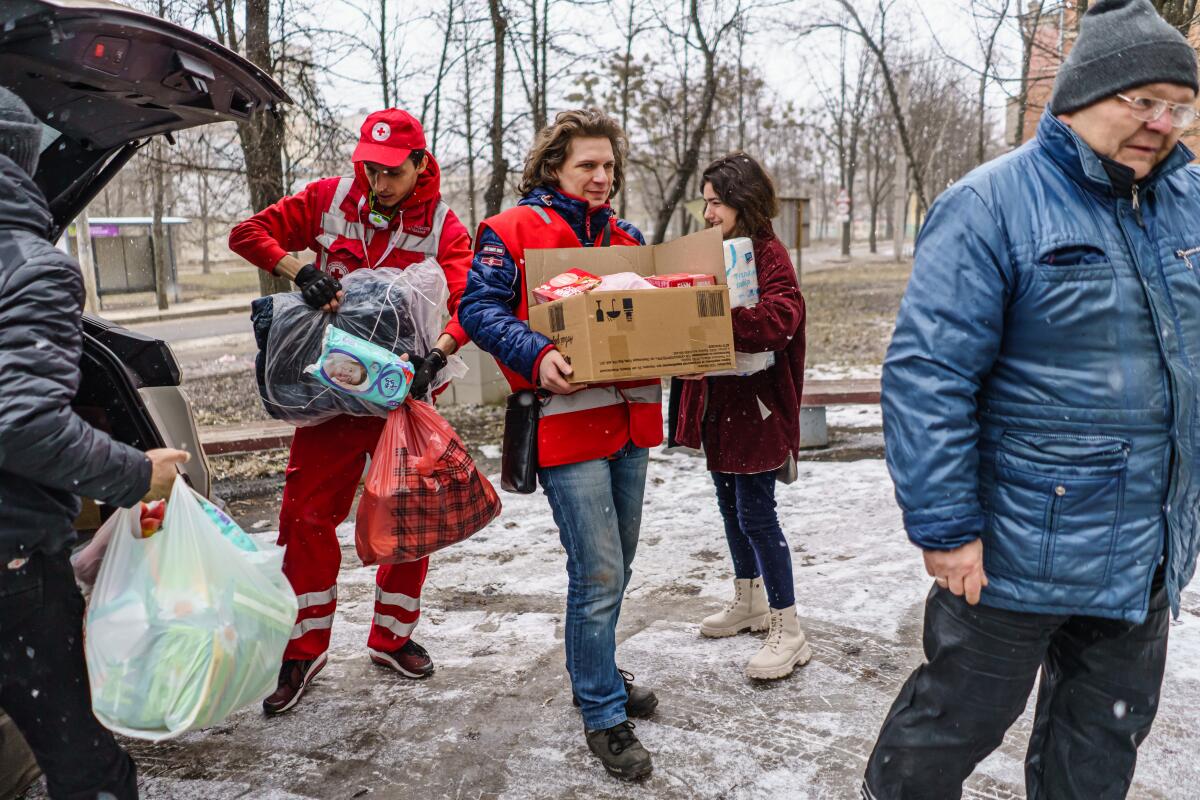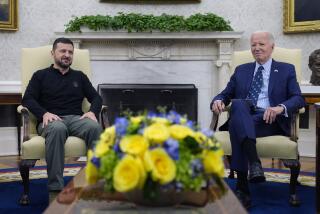Op-Ed: How can we improve humanitarian aid to Ukrainians? Let them control it

Vladimir Putin clearly didn’t expect the strong military resistance Ukraine was able to field when Russian forces invaded six months ago. Nor did Russian leaders expect the Ukrainian state and society to hold together under the sudden onslaught of violence. But hold together they did. Ukrainian civil society, volunteer networks and local officials sprang into action, launching one of the largest humanitarian responses under fire in modern history. Together, Ukrainians housed, fed and moved millions of their fellow citizens to safety.
The initial relief operation was so successful because it was organized and led by Ukrainians. This may seem like common sense. But, during a war, humanitarian assistance is often delivered by international aid agencies. For years, the aid community has promised to put local entities in charge of these efforts.
The “Grand Bargain” that many donor countries and aid organizations agreed to in 2016, along with a more recent international push, is trying to place the decision-making and resources into the hands of those in communities in crisis. Ukraine offers the aid community a golden opportunity to finally make good on these commitments.
Unfortunately, six months into the Russian invasion, this opportunity may be slipping away.
It is becoming increasingly difficult for the largely volunteer efforts to sustain themselves. This may seem odd as state donors have generously pledged support for Ukraine. More than $12 billion, mainly from the U.S. and Europe, is making its way to help Ukrainian citizens inside the country. However, almost all the money is flowing first to international aid agencies. Next to nothing is going directly to the Ukrainians who led the initial response.
As donations flood in, United Nations agencies and international nongovernmental organizations are supersizing their own budgets and staff. Dozens of foreign NGOs have grown from tiny footprints in Ukraine to multimillion-dollar operations. The result is an aid economy in which comparatively costly foreign humanitarian organizations hold the purse strings and make the decisions. At the main humanitarian coordination forum in Ukraine, only two of the 19 representatives are from Ukrainian organizations.
As the new aid economy gathers pace, international aid agencies are scrambling to partner with Ukrainian groups. However, the partnering process is proving challenging. Ukrainian groups can clearly deliver aid, but few have experience in navigating the humanitarian aid bureaucracy and requirements. This leads international agencies to compete for a handful of well-positioned Ukrainian groups that are skilled in dealing with foreign donors. The result is predictable overlap, missed opportunities and bottlenecks.
Some humanitarian workers are also concerned about the growing diversion of talented Ukrainians who are in the middle of a headhunting scrum launched by many foreign aid agencies. The prospect of high salaries and careers at international organizations is siphoning talent away from local groups as well as vital government functions. This trend could hollow out Ukrainian institutions.
As a result, several Ukrainian and international experts are urging a swift change of course. In an open letter released in July, dozens of Ukrainian and foreign groups declared that donors should insist that international agencies work toward strengthened local leadership, including choosing Ukrainian NGOs as the main recipients of humanitarian grants.
Nothing about this challenge is new. Donors and international aid agencies have long wrestled with how to avoid building parallel administrative systems while running a major humanitarian response. These systems can undermine national institutions and citizens’ ownership of aid delivery. Ukraine has a strong state, a relatively robust social safety net and a rich civil society that includes the hundreds of NGOs that were the main reason the initial aid response worked. Collectively, these institutions offer an ideal chance to avoid the mistakes of the past.
Nevertheless, donors are falling back into old habits. Take cash assistance, one of the better ways to reach those who need aid. Rather than routing all the money through Ukraine’s existing social safety net, donors are also sending hundreds of millions of dollars to more than half a dozen international aid agencies who in turn are building multiple cash assistance programs of their own.
Why is all of this happening?
One major reason often cited for working through international aid agencies is concern over public sector corruption in Ukraine. In addition, donors such as the U.S. and the European Union are still ill-equipped, politically disinclined — and often legally prevented — from directly funding local groups. As a result, international NGOs and U.N. agencies end up serving as intermediaries even in a country like Ukraine where the combined capacities of the public, private and civil society sectors are high.
To further complicate matters, there appears to be a high degree of aid mixing between civilian and military beneficiaries by some local groups. This violation of the core humanitarian principle of neutrality is sparking serious concerns among international aid agencies over how they can develop local partnerships while maintaining their own principled role.
Before the problematic aid practices of the past get baked in, foreign donors should craft a plan to put Ukrainians in charge of the humanitarian response in their own country. This would turbocharge efforts to train Ukrainian organizations to deal directly with donors. It could also set out specific steps for donors to relax their own complex requirements to make it easier to get aid directly to Ukrainian organizations.
Donor requirements are designed to ensure accountability and effective aid delivery. But Ukrainian groups have already proved themselves to be effective. What’s more, Western governments have adopted a “no regrets” approach to arming Ukraine, despite the very real risk of diversion of security assistance. So it should be politically possible for Western governments to take similar risks when it comes to humanitarian assistance and get it directly into Ukrainian hands.
Donors should also try to deal with corruption head-on rather than build foreign systems to work around. They should surge support to improve the transparency and accountability of the Ukrainian public sector even as they localize aid. This may sound daunting, but there is reason for optimism: Ukrainians broadly want to tackle corruption, and the highly digitalized country could rapidly put anti-corruption systems in place. Finally, the current donor bill for humanitarian aid is hefty, but it will pale in comparison to future budgets for reconstruction. It behooves everyone to address corruption now so Ukraine can be prepared to rebuild in the future.
Admittedly, there is no silver bullet for the complicated issue of aid mixing between military and civilian beneficiaries. But donors can prioritize Ukrainian organizations willing to deliver aid according to international humanitarian norms. International aid agencies can help by providing local organizations with technical advice and guidance.
Six months into this war, the aid community has reached a critical juncture. Budgets and practices are getting ever more fixed and resistant to change. Putting aid in Ukrainian hands, with some know-how from the outside, will empower Ukrainians and strengthen their civil society and state. It will also show that humanitarians have the capacity to change course — and do what everyone has long thought best.
Hardin Lang is the vice president of Refugees International and Nicholas Noe is a consultant for Refugees International.
More to Read
A cure for the common opinion
Get thought-provoking perspectives with our weekly newsletter.
You may occasionally receive promotional content from the Los Angeles Times.










